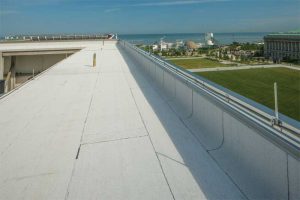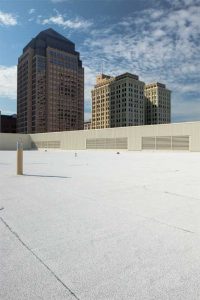by Amanda Boyer

The 2010s were marked by shorter winters, longer heat spans, and record-setting temperatures around the globe. According to the European Union’s Copernicus Climate Change Service, 2019 was the second hottest year on record, beaten by 2016 by less than 3/50 C (1/10 F). As greenhouse gas (GHG) emissions continue to trap heat and make homes and businesses more difficult to cool, cities are struggling to keep up with the demand on local energy grids.
While the late 2010s experienced a construction boom, higher cooling demands are making owning a home, running a business, or staffing an office building more costly in ways that threaten to dampen industry growth. It is incumbent upon designers, architects, and specifiers to factor in the costs of rising temperatures, and incorporate temperature-lowering cool roofs into their recommendations. The incentives, as well as the technology to do so, have been steadily improving.
Cool roofing and energy use
Americans are by far the most prolific users of air-conditioning (87 percent of all homes), more than the rest of the world combined. According to the U.S. Energy Information Administration (EIA), air-conditioning accounts for 12 percent of the country’s total energy use. Long before the advent of modern air-conditioning units, builders understood the roof’s capacity to retain heat and make living conditions unbearable.

Roofs have the most exposed surface area of any part of the building, so it makes sense the materials and coatings used on it have a big impact on the comfort of occupants. If white tunics have worked to keep the sun off desert travelers for several millennia, then why not apply the same tactics to roofing? Throughout the Mediterranean and Middle East, buildings with white exteriors have been common for centuries. Examples include the labyrinth of Byzantine-influenced buildings in Ostuni, Italy, and the stunning white-washed villas of Santorini, Greece.
When light touches any surface, some of its energy is reflected and some absorbed. Individual colors are how the brain perceives the wavelength of the reflected light. White light contains all the wavelengths of the visible spectrum, so when the color white is reflected, all wavelengths are also reflected, making it the most reflective hue.
In the 1980s, the U.S. Department of Energy (DOE) began researching the benefits of reflective roofing in urban environments with the goal of reducing high temperatures caused by dark roofing, asphalt roads, and other heat-absorbing building materials (known as the ‘heat island effect’). They found white or reflective roofs typically only increase 6 to 14 C (10 to 25 F) above ambient air temperatures during the day, which translates up to 15 percent savings on air-conditioning use over the course of a year for a typical one-story residence.
In 1998, the Cool Roof Rating Council (CRRC) was established to develop credible and universal methods to evaluate and classify the solar reflectance and radiative properties of roofing products, and share that information publically. “Coolness,” as defined by CRRC, is measured by two properties:
- solar reflectance (the fraction of solar energy reflected by the roof); and
- thermal emittance (the relative ability of the roof surface to radiate absorbed heat).





Amanda might have mentioned that green vegetative roofs are significantly cooler than reflective roofs that merely reflect heat back up into the atmosphere. In fact, vegetated roof surfaces are typical several degrees cooler than ambient temperatures due to the plants transpiration cooling affects.
This reduction in the urban heat islands from roof surfaces is only one of dozens of green roof benefits most importantly including storm water management and reduction in carbon dioxide emmissions.